Have you ever wondered what would happen if a sudden accident on a roofing job cost thousands in damage or injury claims? In a city like Brooklyn or anywhere in NYC, a single mistake on a roof can turn into a financial nightmare without the right protection in place. That’s where Roofing Insurance steps in; it’s not just a policy, it’s your safety net that keeps your business, your crew, and your clients secure when things go wrong.
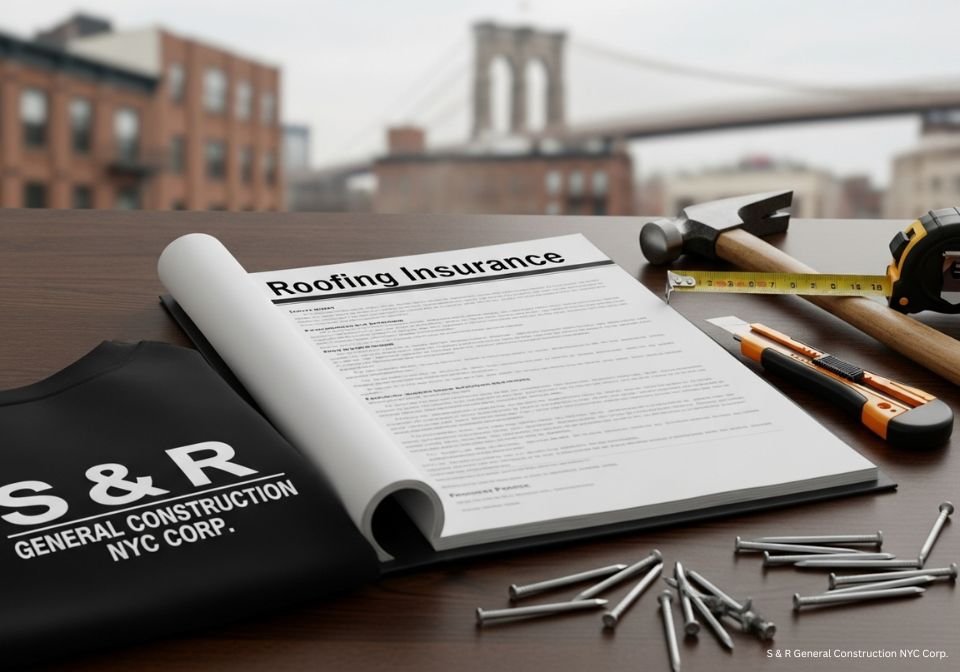
In this detailed guide, we’ll break down everything you need to know about Roofing Insurance in Brooklyn and across New York City. You’ll learn what roofing insurance really means, the policies every roofer should have, and the local laws that shape how insurance works here. We’ll also look at the costs, claims process, and smart ways to lower your premiums without cutting corners.
What Is Roofing Insurance?
Roofing insurance is a bundle of business policies that protect roofers, clients, and properties during roof work. Contractors rely on it to handle injuries, accidental damage, and legal claims. Homeowners and property managers care because insured crews reduce risk on their buildings. In New York City, permits and job access often depend on having the right insurance in place.
- General Liability: Covers third-party injury and property damage on or around the job site. NYC’s Department of Buildings (DOB) ties permits to proof of GL coverage, and some projects require high, project-specific limits.
- Workers’ Compensation: Pays medical bills and lost wages for injured employees. New York State requires almost all employers to carry it, so any reputable Brooklyn roofer should have an active policy.
- Commercial Auto: Protects your work trucks and vans during city driving and deliveries. It also covers liability from vehicle accidents tied to the job.
- Tools & Equipment (Inland Marine): Covers theft or damage to tools, ladders, nail guns, and materials on the move or stored on site. Urban projects face more theft exposure, so this policy is a smart backstop.
- Umbrella/Excess Liability: Adds extra limits above GL and auto. New York’s Scaffold Law creates strict exposure for height-related injuries, so many NYC roofing firms buy higher limits.
What Is a Certificate of Insurance (COI)?
A COI is a one-page proof of insurance, usually the ACORD 25 form, that summarizes the contractor’s active policies, limits, effective dates, and insurer details. It shows whether the roofer carries general liability, workers’ comp, auto, and umbrella coverage, and lists endorsements such as additional insured or waiver of subrogation when applicable. NYC DOB publishes exact formatting for COIs it accepts, including the required certificate holder address and minimum GL terms. Ask the broker or insurer for a COI, then verify names, dates, and limits before any roof work starts.
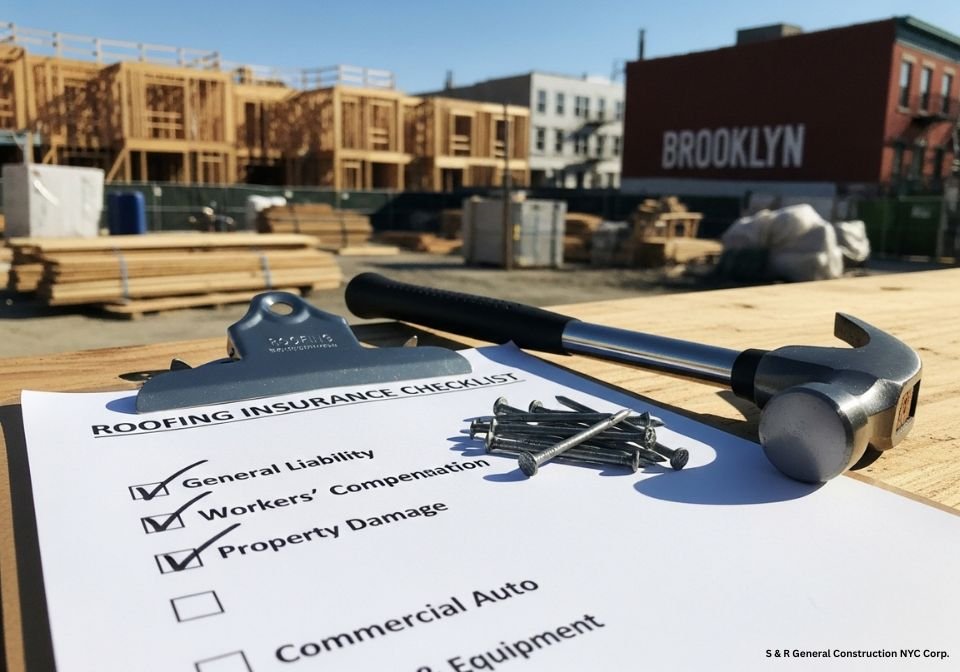
Why Roofing Insurance Is Essential for Brooklyn & NYC Roofers
New York jobs involve working at heights, handling heavy materials, and navigating dense foot traffic around buildings. The right coverage prevents a mishap from becoming a company-ending loss.
- Stay compliant with NYC and NYS rules. The DOB checks that license and insurance records are active when you apply for permits, so you avoid stop-work orders. New York also expects employers to carry workers’ compensation for employees, so you avoid penalties and exposure. These two rules provide a solid legal foundation for every project.
- Get permits and start work without delays. DOB requests proof, including an ACORD COI and, sometimes, project-specific GL documentation. You move from approval to mobilization faster when your paperwork is complete. Your jobs stay on schedule, and your crews stay billable.
- Manage height-related injury risk. New York’s Scaffold Law imposes strict liability for gravity-related accidents on owners and contractors. Proper GL and umbrella limits help absorb catastrophic claims. A single fall can exceed standard limits, so extra protection matters in NYC.
- Protect against property damage in tight spaces. Brooklyn streets, shared walls, and busy sidewalks raise the odds of third-party damage. GL responds when debris shatters a window or water intrusion harms a neighbor’s unit. Strong coverage keeps one mistake from draining cash reserves.
- Win trust with owners and managers. Clients and GCs often request current COIs and endorsements before granting site access. Clear proof of coverage shows professionalism and reduces friction with building management and lenders. Trust grows, and referrals follow.
- Build financial resilience on larger projects. Big buildings and higher roofs come with bigger exposure and higher required limits. Umbrella policies raise your ceiling above GL and auto. That cushion helps your business survive a worst-case claim.
NYC Roofing Insurance Requirements & Regulations
NYC layers city rules on top of state law, so roofers must satisfy both. Permits, license status, and on-site access connect to active, verifiable insurance.
- General Liability is required and tied to permits. DOB states that GL is required for construction and demolition work and uses the project scope and height to determine the required limits. The City can require project-specific GL and the PGL1 form before issuing or renewing a permit.
- Minimum GL terms for licensed contractors. DOB lists a baseline of at least $1,000,000 per occurrence for GL on licensed contractors’ records. Your license and insurance must stay active and current, or permit applications can stall. Keep records in DOB systems up to date to avoid surprises.
- Workers’ compensation is mandated by the state. New York says virtually all employers must provide workers’ compensation coverage for employees. Roofing is high-risk, so inspectors look closely at proof. Active workers’ comp keeps you operating and protects injured staff.
- COIs must follow DOB formatting. The certificate holder must read “NYC Department of Buildings, Attn: Licensing & Exams Unit, 280 Broadway, New York, NY 10007.” DOB lists accepted ACORD versions and requires each insurance type as a separate PDF when you upload. Submissions with the wrong holder text or mixed forms can be rejected.
- Insurance status is checked during permitting. DOB systems verify that your license and insurance are active when you submit a permit application. Expired GL or project-specific policies can cause permit expiration or denial. Keep renewals aligned with project timelines to avoid gaps.
- Height work drives higher limits under city rules. For taller adjacent buildings or major alterations, NYC tables require GL limits well above the minimums. The tool on NYC’s site calculates the amount for your job, so large structures often trigger multimillion-dollar limits. The roof scope should be planned with those tables in mind.
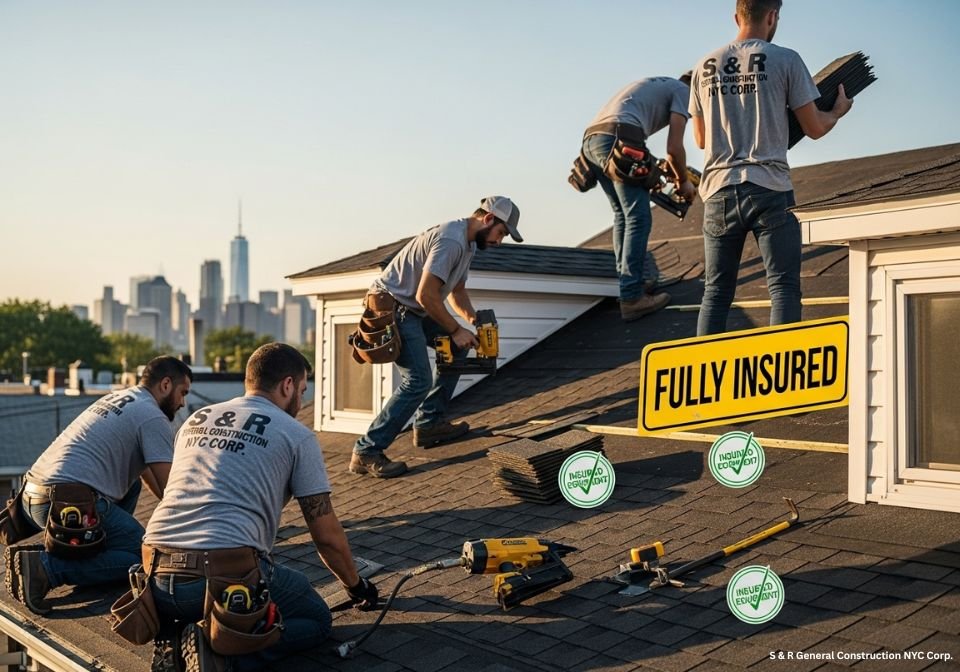
General Liability Insurance for Roofing Contractors
- What it covers. General liability covers claims from third parties for bodily injury, property damage, or personal/advertising injury that arise from your roofing operations. It helps pay settlements, judgments, and legal defense costs, so a single incident does not cripple your business.
- Real-world claim examples. A passerby trips over staging and suffers an injury on the sidewalk, or falling debris cracks a neighbor’s skylight. These are classic third-party claims that fall under a roofer’s general liability policy.
- Coverage limits that fit NYC jobs. New York City requires licensed contractors to carry at least $1,000,000 per occurrence in general liability insurance, and projects may require higher limits before permits move forward. Many roofers pair a $1M/$2 GL with an umbrella for extra protection on tall or complex buildings.
- Proof owners and agencies expect. Building owners, GCs, and NYC’s Department of Buildings request a current ACORD Certificate of Insurance that shows active GL coverage, with the correct certificate-holder language. Submissions that do not conform to DOB formatting can delay permit issuance.
- Defense outside the limits on many policies. GL can include legal defense for covered claims, which is vital when incidents happen near crowded sidewalks or shared walls common in Brooklyn. Check your policy form to confirm how defense applies to your limits.
Workers’ Compensation Insurance for Roofers
New York State says most employers must carry workers’ compensation for their employees. Roof work poses elevated hazards, so inspectors closely review proof of active coverage in permit and license files.
Workers’ compensation pays medical care and wage benefits when a covered employee gets hurt on the job. It is separate from general liability and protects both your crew and your company’s finances after an injury.
Going without coverage creates serious exposure in New York. The Workers’ Compensation Board can issue penalties of up to $2,000 for each 10-day period without insurance, and repeat or large violations can result in felony charges and higher fines. Agencies also verify comp coverage when businesses apply for permits, licenses, or contracts.
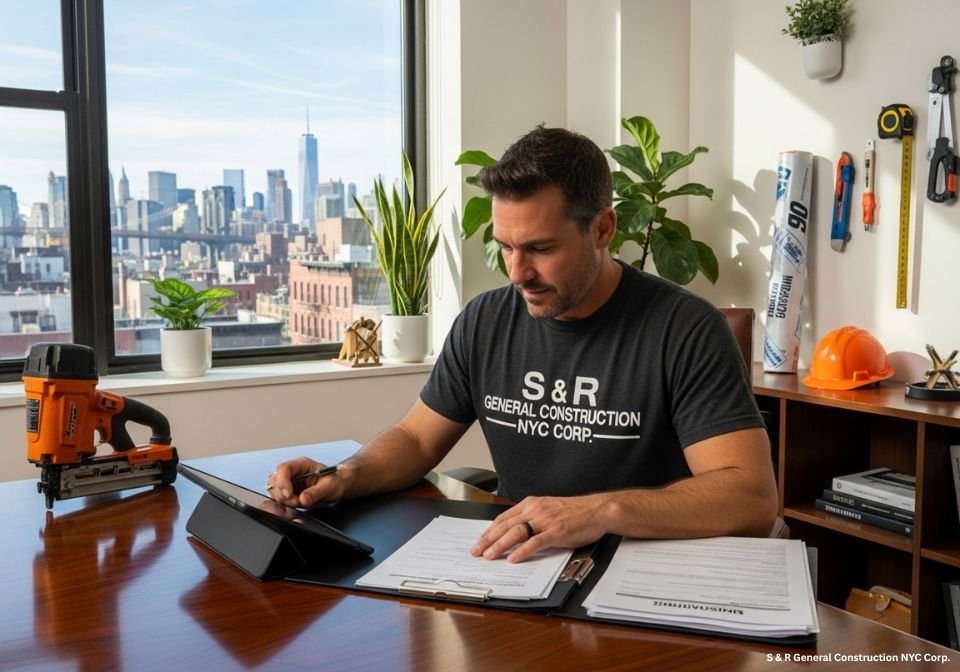
Commercial Property & Equipment Insurance for Roofers
Your shop, office, and stored materials face risks like fire, theft, and vandalism, so a commercial property policy helps pay to repair the premises and replace covered business property. Tool theft is common in dense urban areas, which makes the “contents” part of property coverage important for Brooklyn contractors.
Roofers also rely on contractors’ equipment/inland marine coverage because tools and machinery move from the yard to the truck to the jobsite. Inland marine “floats” with movable gear and can cover stolen or damaged tools and equipment at the site, in transit, or in off-site storage. Pairing property with inland marine closes gaps left by standard property policies.
Commercial Auto Insurance for Roofing Businesses
Company pickups, vans, and box trucks need commercial auto, not personal auto, when used for business. Liability coverage pays for injuries and property damage you or your employees cause in a work-related crash, and physical damage options can cover your vehicles after a collision or comprehensive losses.
Personal auto policies usually do not cover business use, which puts you at risk when a crew member drives to a Brooklyn jobsite with materials. A proper commercial auto policy can include higher liability limits that match city exposures and satisfy contract requirements.
Surety Bonds for NYC Roofing Projects
- When you need a bond for licensing. If you do home improvement work in NYC, the Department of Consumer and Worker Protection requires either enrollment in its Trust Fund or a $20,000 Home Improvement Contractor surety bond to get your license. The official checklist spells out the bond option, the exact certificate holder, and proof rules.
- When public or large jobs ask for bonds. On public works in New York, agencies must require a payment bond to protect subs and suppliers under the state’s “Little Miller Act” (State Finance Law §137). Owners or agencies also often require a performance bond to guarantee completion, especially on bigger capital projects.
- Private owners and GCs may ask as well. Large private projects in the city may require performance and payment bonds as part of the contract to ensure the work has a financial backstop. That shows financial strength when you bid.
- How a bond differs from insurance. A surety bond is a three-party guarantee (you, the surety, and the project owner). If the surety pays a valid claim, it can seek reimbursement from you, so the risk ultimately sits with the contractor. By contrast, insurance is a two-party risk transfer.
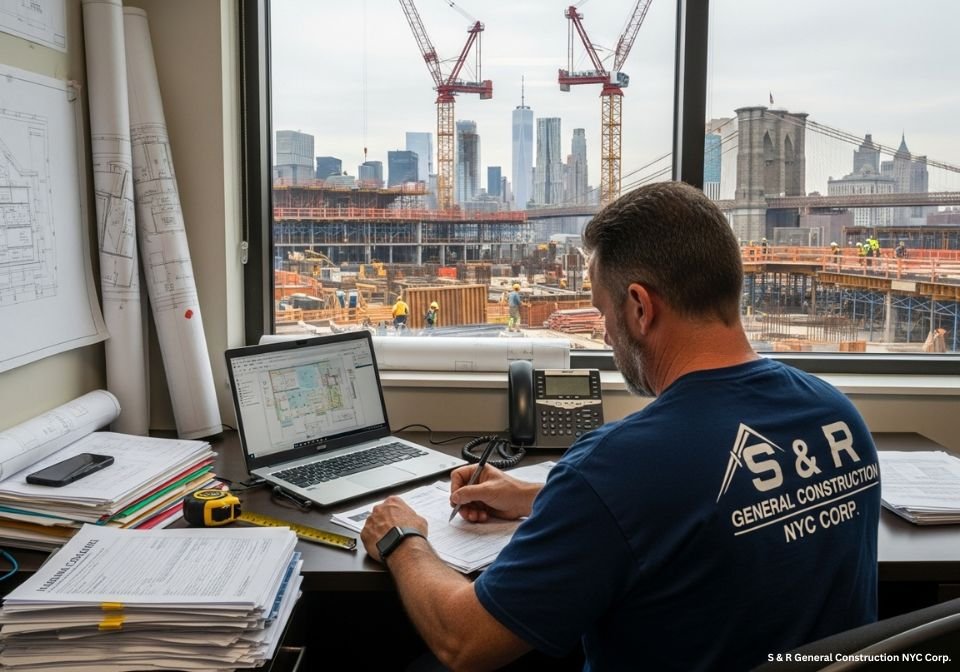
Umbrella Insurance for Additional Protection
City projects can push liability exposure far above standard limits. Commercial umbrella insurance adds an extra layer of liability on top of your general liability and auto policies, so one large claim does not exhaust your base coverage.
Many NYC jobs also require project-specific GL limits tied to height and adjacent buildings, so an umbrella helps you meet higher combined limits without rewriting every primary policy. Think of it as headroom for rare, high-severity losses on tall or complex buildings.
Factors Affecting Roofing Insurance Premiums in Brooklyn, NYC
- Height and project complexity. NYC’s Department of Buildings requires GL limits based on the job type, the height of your structure, and the tallest adjacent building; larger structures require higher limits, which can raise premiums.
- Scaffold Law exposure. New York’s Labor Law §240 imposes absolute liability for gravity-related injuries, which contractors say drives liability premiums about 30% higher than in other states. That legal climate pushes both GL and umbrella pricing.
- Weather and urban density. Wind, heavy rain, and tight sidewalks increase the risk of falling debris or water intrusion. In dense blocks, a single incident can touch multiple properties, so carriers price for that urban risk.
- Safety record and claims history. Prior claims and OSHA issues tend to follow you for years, and they can affect renewal rates. A clean record gives you better quotes.
- Payroll and crew size. Workers’ comp and some liability classes are rated off payroll and employee count, so more hours at height raise cost.
- Coverage limits and equipment values. Higher per-occurrence limits cost more. Expensive gear and vehicles also push property/inland marine and auto premiums upward.
Average Roofing Insurance Cost in Brooklyn, NYC
Benchmarks vary by business size and exact work, but recent market data gives useful anchors for New York roofers:
- General Liability (GL): about $453/month on average for New York roofers, higher than the national average. Project-specific GL requirements in NYC (PGL1) can push total required limits far above the standard $1M/$2 limit, thereby impacting costs.
- Workers’ Compensation: about $970/month on average for New York roofers in a small-business profile. Payroll, class code exposure, and loss history move that number.
- Why does NYC run higher? Liability premiums in New York generally run ~30% higher than in other states, a gap the industry links to Scaffold Law’s absolute-liability standard. Add DOB’s height-based insurance tables and dense urban risk, and Brooklyn contractors face pricier coverage than peers in many regions.
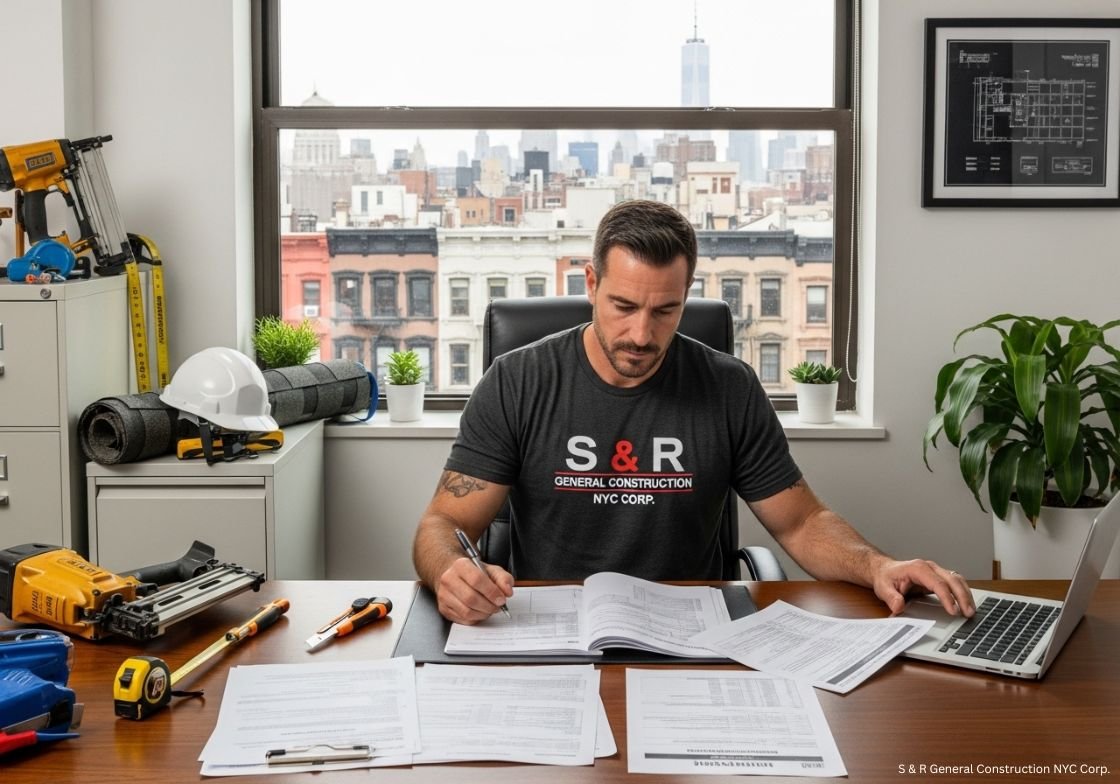
Tips to Lower Roofing Insurance Costs
Smart savings start with a plan, not cuts to protection. You keep coverage strong and trim waste by improving risk control and ensuring clean paperwork.
- Build a real safety program. Train crews on fall protection and daily job-hazard checks. Fewer injuries mean fewer claims, and carriers reward that history with better rates. Keep written policies and toolbox-talk logs as proof when you renew.
- Raise deductibles with care. A higher deductible lowers your premium and keeps small losses off your record. Set aside reserves so cash flow can handle that out-of-pocket hit without stress. Talk through scenarios with your broker before you change terms.
- Bundle policies and right-size limits. Package GL, auto, and property to qualify for multi-policy credits. Use an umbrella to meet NYC’s higher contract limits instead of maxing every primary policy. You get flexibility for bigger jobs without overpaying across the board.
- Tighten subcontractor risk transfer. Collect COIs before work starts and require additional insured and waiver-of-subrogation endorsements. Action-over exposure under New York’s Scaffold Law hits owners and GCs hard, so you want subs properly covered. This step protects your loss history and your premium.
- Protect tools with the right form. Inland marine (contractors’ equipment) covers gear on trucks, at jobs, and in storage. Urban theft and transit losses punish budgets, so this policy stops nickel-and-dime claims from rolling into GL. Document serial numbers and keep photos for fast replacements.
New York Scaffold Law (Labor Law 240) and Its Impact on Roofing Insurance
Labor Law §240 sets strict or absolute liability for gravity-related injuries against owners and contractors. That legal standard drives higher claim costs and pushes GL and excess/umbrella premiums up across New York. Roofing crews work at height every day, so carriers price for that exposure in Brooklyn and across NYC. Proper limits and clear “action-over” wording in your policies help protect the business when a serious fall claim arises.
Roofing Insurance Claims Process
- Put safety first and prevent more damage. Board broken windows or tarp roof holes; save every receipt for emergency work; hold off on permanent repairs until your insurer inspects.
- Report the claim right away. Call your insurer or agent as soon as you spot damage and follow up in writing; late notice can risk denial.
- Document everything. Take photos and videos, make a room-by-room list of damage, and keep a dated log of calls and emails.
- Meet the adjuster prepared. Have estimates, receipts, and your damage list ready; walk the adjuster through the site, note their contact info, and outline next steps.
- Track extra living costs if you can’t stay at home. Keep hotel, meal, and laundry receipts; many policies pay “Additional Living Expense” after a covered loss.
- Know common exclusions. Wear-and-tear and poor maintenance usually sit outside coverage; claims tied to sudden events (like wind or a fallen tree) fare better—ask the insurer to point to the exact policy clause if coverage is disputed.
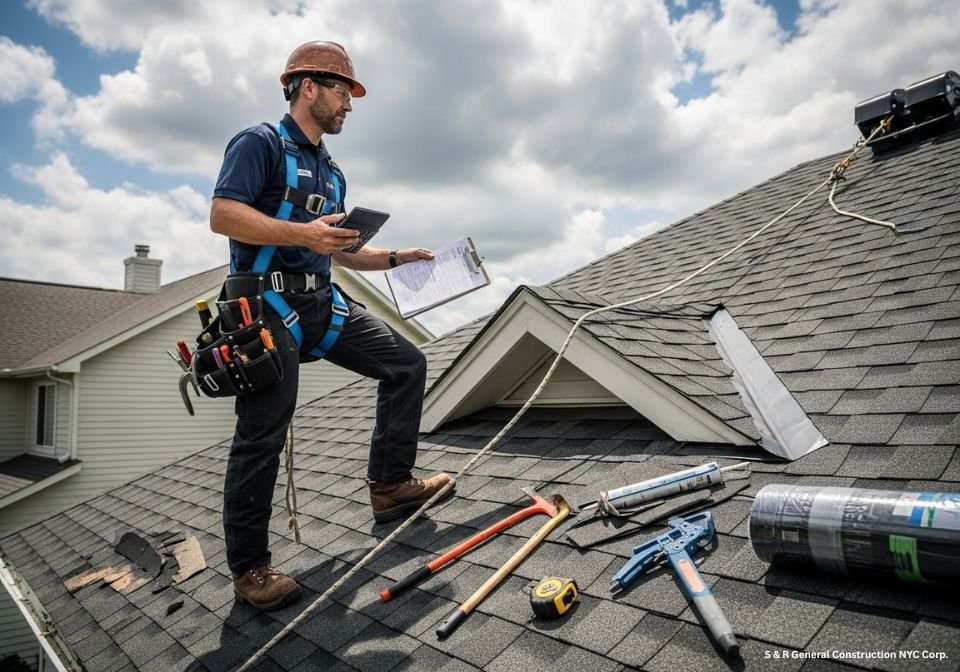
Choosing a Roofing Insurance Provider in Brooklyn, NYC
If you want a local partner who knows the borough and cares about your job, talk to SR General Construction at 8807 Avenue B, Brooklyn, NY 11236 in the Canarsie area. Our team runs fully insured projects, and we help clients handle roofing insurance paperwork with clear COIs and fast responses. We also back our work with a 12-year warranty, so owners feel safe from day one to year twelve.
FAQ
1. Do NYC roofers need General Liability (GL) insurance to pull a permit?
Yes. NYC DOB ties permits to proof of GL and may require a project-specific GL submission before issuing or renewing permits.
2. What GL limit does DOB expect at a minimum?
DOB’s licensing insurance guidelines state that at least $1,000,000 per occurrence must appear on file for licensed contractors.
3. What is the PGL1, and when is it required?
The Project-Specific General Liability Insurance Summary & Affirmation (PGL1) is generated by DOB’s tool and must be submitted when DOB flags your job for additional, project-specific GL. This often applies to larger or higher-risk work.
4. What must a contractor’s Certificate of Insurance (COI) show for DOB?
COIs must use specific holder text: “NYC Department of Buildings, Attn: Licensing & Exams Unit, 280 Broadway, New York, NY 10007,” with typed info only, and each insurance type uploaded as its own PDF.
5. Does a COI make me an Additional Insured (AI) or guarantee coverage?
No. A COI is informational; AI status and key terms (e.g., primary/noncontributory) only exist if the policy includes the proper endorsements (often captured via the ACORD 855 NY addendum).
6. How can I verify a roofer’s license and insurance status in NYC?
Check DCWP’s license lookup for Home Improvement Contractors and DOB’s License/Registrant Search for skilled-trade/GC registrations. Use these before making any deposit or accessing the site.
7. I have no employees—can I still get permits without a comp policy?
If you truly have no employees, you can file a CE-200 Certificate of Attestation of Exemption for licenses/permits. Use the state’s portal to request it.
8. How do I verify a CE-200 is valid?
Use the Workers’ Compensation Board’s CE-200 verification page to confirm the certificate. Agencies often require this check before issuing permits.
9. ACV vs. RCV for roof claims—what’s the difference?
ACV pays the roof’s depreciated value; RCV pays the cost to replace it with something of like kind/quality (often after you complete repairs). That distinction can change your out-of-pocket by thousands.
